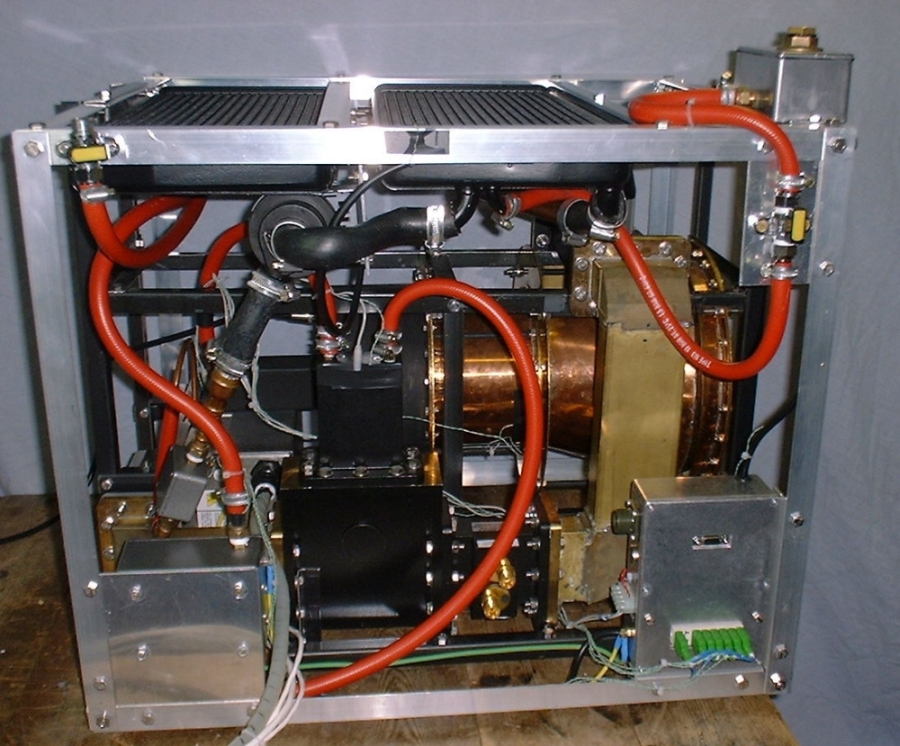SourceThe Emdrive is an electromagnetic drive that would generate thrust from a closed system — “impossible” say some experts.
To critics, it’s flat-out junk science, not even worth thinking about. But its inventor, Roger Shawyer, has doggedly continued his work. As Danger Room reported last year, Chinese scientists claimed to validate his math and were building their own version.
Shawyer gave a presentation earlier this week on the Emdrive’s progress at the CEAS 2009 European Air & Space Conference. It answered few questions, but hinted at how the Emdrive might transform spaceflight — and warfare. If the technology works, that is.
The heart of the Emdrive is a resonant, tapered cavity filled with microwaves. According to Shawyer, a relativistic effect generates a net thrust, an effect confirmed by various Emdrives he has built as demonstrations. Critics say that any thrust from the drive must come from another source. Shawyer is adamant that the measured thrust is not caused by other factors.
While the argument over the drive’s impossibility continues, so does the engineering work. The problem is that nobody wants to talk about it. Even Shawyer gives little away.
Last year, professor Yang Juan of the College of Astronautics at Northwestern Polytechnical University (NPU) in Xi’an was happy to confirm that they were building an Emdrive which would be tested by the end of the year. But following the publication of this news in Danger Room, the situation changed. I was informed that the publicity was very unwelcome, especially any suggestion that there might be a military application. (Yang had previous published a study on the use of plasma as a weapon against low-orbiting satellites. [.pdf]) No further information has been forthcoming, and no Chinese papers have been published on the Emdrive, though Yang has recently published work on (unrelated) microwave plasma thrusters (.pdf).
Shawyer asserts that work is also being carried out in France, Russia and in the United States by a major aerospace company. But he cannot provide details beyond vague promises of “significant progress [that] has been made in both theoretical and experimental work, within these groups.” He also asserts that the British National Space Centre is said to be reviewing the Emdrive. Again, no details.
The CEAS 2009 paper outlines recent progress and plans. Previous thrusters generated relatively modest forces; the latest version now being built is based on a cooled superconductor and should generate more than 300 pounds of thrust for a 6-kilowatt input, Shawyer promises. (But does not yet appear to have done so.) The plan is to mount four of these thrusters on an unmanned demonstration vehicle that will weigh about 1,000 pounds. The craft will have no wings: It will be supported by the Emdrives and propelled by jet engines to about 230 knots. It will be capable of vertical takeoff and hovering silently in place. If successful, it will be adapted as a personal transport -– your very own flying car.
In the longer run, perhaps 10 years, Shawyer envisages a hybrid spaceplane using Emdrive technology — see the photo above of a 2-meter scale model. The idea is a craft capable of making the 10,000-mile run from London to Sydney, Australia in under three hours … or taking a 40-ton payload on the moon in about four days.
Aeronautical engineers have been dreaming of such a craft for decades; none have ever panned out. The theoretical advantage of the Emdrive spaceplane compared to rockets is that it allows a slow ascent with low acceleration rate. There is also no telltale rocket exhaust plume, and this may be the source of some of the interest. At present, the launch of a ballistic missile anywhere on Earth can be immediately spotted from space. An Emdrive-based launch system would be undetectable and could arrive from any direction, leaving the target of an attack no way of knowing who to retaliate against.
This is the kind of factor that might drive governments to put money into Emdrive projects. An investment in contested science is not a probable winner — but the payoff could be a big one.
Here we go!!!! Exciting times!!!!
Wiki link to Emdrive
Video of it in action
Notes on Test video:
The field strengths within the thruster equate to a power level of 17MW. Signal leakage causes EMC effects within the fixed video camera. This leads to the apparent vertical movements.
The engine only starts to accelerate when the magnetron frequency locks to the resonant frequency of the thruster, following an initial warm up period. This test operation eliminates possible spurious forces.
The rotary air bearing supports a total load of 100kg, with a friction torque resulting in a calibrated resistance force of 8.2 gm at the engine centre of thrust.
For this test a thrust of 96 mN was recorded for an input power of 334 W.


Presentation to the 2008 space conference
http://www.slideshare.net/Stellvia/...ce-08-conference-barbican-london-presentation
SourceThe British National Space Centre's technology and industrial policy deputy director has told Hyperbola that 2010 could see a workshop on the Emdrive to bring together the expertise to tackle the "underlying physical phenomena" that is seen in the video above
Link to the theory paper from New Scientist:
http://www.newscientist.com/data/images/ns/av/shawyertheory.pdf
Link to the revised version of his theory shown at IAC 2008 conference
http://www.emdrive.com/IAC-08-C4-4-7.pdf
Link to New Scientist article covering the topic:
http://www.newscientist.com/article/mg19125681.400-relativity-drive-the-end-of-wings-and-wheels.html
Q. Why does the EmDrive not contravene the conservation of momentum when it operates in free space?
A. The EmDrive cannot violate the conservation of momentum. The electromagnetic wave momentum is built up in the resonating cavity, and is transferred to the end walls upon reflection. The momentum gained by the EmDrive plus the momentum lost by the electromagnetic wave equals zero. The direction and acceleration that is measured, when the EmDrive is tested on a dynamic test rig, comply with Newtons laws and confirm that the law of conservation of momentum is satisfied.
Last edited:



